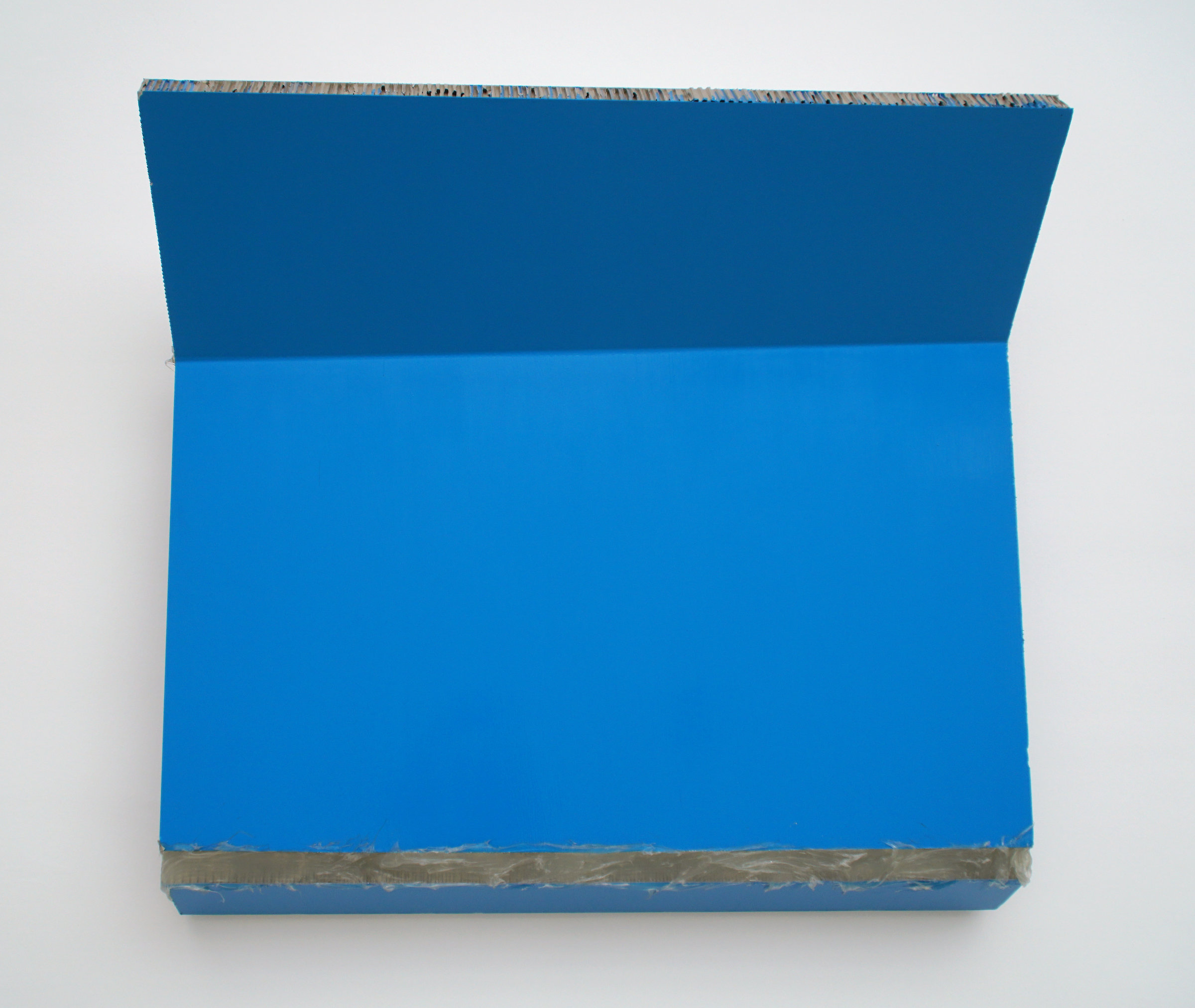Steven Parrino

Untitled, 1995
Acrylic on aircraft construction materials
130 × 125 × 30 cm
Courtesy Collection Alexandra and Rolf Ricke, Berlin
This untitled work is part of Parrino’s Bent Paintings series, which is an important point of reference to understand his reduced form of painting. When Steven Parrino (*1958 New York, †2005) was studying at the New School in New York in the late 1970s, he was explicitly advised against painting, because art critics were said to have declared it dead. His turn to painting can therefore be understood as something nonsensical, as a revolt against any form of dogmatism. This resistance is closely connected to Parrino’s interest in the American subculture of the 1980s, such as punk, no wave, and weird comic books.
His approach to the medium of painting is correspondingly free. For the older works of the Bent Paintings series, the artist used sheets of cardboard found in the trash before he began working with aluminum panels originally intended to build aircraft. The panels serve as supports for abstract, monochrome painting but he broke and bent them to incorporate the surrounding space into their structure. Although this procedure would appear to be a deformation of painting, that is not the focus for Parrino. Rather, the break or tear served him as an aesthetic means to question the requirements of the medium. The artist was primarily concerned with proposing an alternative to the view of art of modernist painting that viewed abstraction as an expression of purity and strove to transcend reality. Parrino’s self-declared goal was to topple this view and connect painting to the zeitgeist again and confront it with the immediacy of reality.
Finally, the fold that results from bending can also point to an intermediate space for new thinking, which in the tear can also result in a rejection of society to the point of a rift. In the context of this exhibition, the color blue and the fold in the canvas can also be thought of as a relationship to the common idea of Europe which is a tense one in many places.

Idiot, n.d.
Enamel and spray paint on tracing paper
23 × 23 cm
Courtesy Collection Alexandra and Rolf Ricke, Berlin
Parrino’s work is distinguished by a great openness to the cultural and political situation of his time and does not shrink from confrontation either. In the center this work on paper in the exhibit, the artist applied the word “IDIOT” in black spray paint and thus addressed his vis-à-vis directly. In the reduction of the colors to black and white and the graphic design of the word, the artist is employing trashy, direct aesthetic that has a clear connection to the music and underground culture of New York.
Parrino belonged to a generation that had grown up with the new mass medium of television in the 1960s and 1970s and for which violence was omnipresent. Not long before that, “America” still presented the image of a glorious nation that embodied more than any other country the global triumph of capitalism. This idea was, however, lastingly overshadowed by the unending images of war and by fear of nuclear annihilation. Parrino employed this word as an appellative and yet addressed it to the public in a way that was almost in passing, as a means of dissociating from a uniform culture. This accusation can be understood as an expression of discontent and rejection that supports the unreconcilable attitude of underground culture and positions it against mass culture. But to what extent can a minority cultural group assert itself against the unpopular conditions of a dominant mass culture? The concept of the “underground” associated with that can be a way out if one considers that mass culture’s appropriation is only superficially successful and can be rejected by simple linguistic gestures.
In the meantime, the dominance of the mainstream has put every form of countercultural life to its own use, which makes it even more difficult to have the necessary critical debates over a contemporary form of coexistence of the equal but different.
Steven Parrino
has had solo exhibitions amongst others at The Power Station, Dallas; Gagosian Gallery, Paris; at Kunstmuseum St. Gallen, St. Gallen; Palais de Tokyo, Paris; at the Musée d’Art Moderne et Contemporain, Geneva; the Team Gallery New York; Milano Gallery Jean Brolly, Paris; Circuit, Lausanne; the Grazer Kunstverein, Graz; and Massimo de Carlo Arte Contemporanea, Milan.
His works were shown in group exhibitions at Hirshhorn Museum and Sculpture Garden, Washington, D.C.; at FRAC Bourgogne, Dijon; at MAC Lyon, Lyon; at Marlborough Gallery Chelsea, New York; Art & Public, Geneva; the Yerba Buena Center, San Francisco; the Museum of Modern Art, Frankfurt; Lyon Biennale, Lyon; Ludwig Museum, Cologne; Kunstmuseum St. Gallen, St. Gallen; Tomio Koyama Gallery, Tokyo; at the Museum Fridericianum, Kassel; the Centre Georges Pompidou, Paris; and at Kölnischer Kunstverein, Cologne.